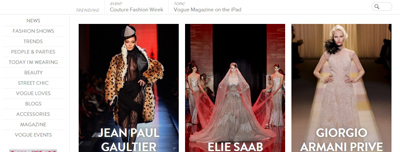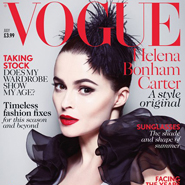Ninety-three percent of magazine readers said that they engage with print advertisements, according to a report from Condé Nast's British Vogue.
The "Vogue Business Report" found that glossy magazines still hold considerable advertising influence in an evolving media landscape. Ad engagement levels are up in all areas, and across the board Vogue is regarded as the chief arbiter of fashion, the report claims.
"Luxury brand marketing and communication directors are hungry to have ad engagement numbers on print, Web site and digital from the point of view of the effectiveness of these cross-platforms with readers and consumers," said Stephen Quinn, publishing director of Vogue, London.
"We are helping to establish a value system on these media assets," he said.
The online research for the Vogue Business Report took place in March and April. YouGov, a research company based in Britain, compiled and analyzed the data.
Plucking information
Ad engagement for Web sites increased from 60 percent in 2011 to 71 percent in 2012. This hike likely stems from the transformation of http://vogue.co.uk.

British Vogue Web site
Seventy-six percent of respondents deemed Vogue as the magazine with the strongest ability to make ads desirable.
Additionally, 60 percent of respondents declared British Vogue's Web site to be the most influential.

British Vogue Web site
The report also delves into the impact of various touch points on consumers' purchasing decisions.
Overall, monthly magazine advertising and samples in magazines, ranked as the most trusted paid touch points, netting 64 percent.
Face-to-face recommendations led the pack in the earned media touch points category.
Consumers are split into three categories in the report: Fashion First, Fast Functional and Traditional.
Fashion First consumers are the most astute, with penchants for all media and a deep interest in the fashion industry.
Fast Functional consumers erratically consume digital media and also buy their products online.
Traditional consumers tend to stick with print and are a dwindling segment.
"We love having all three clusters, Fast Functional, Fashion First and Traditionalists, in the mix because they reflect the social times we are living through," Mr. Quinn said.
"These groups are all vital to us in holding circulation numbers in print and in the tablet form," he said.
Sweeping the steps
The report polled 2,328 women ages 20-54 who read at least one of the key magazines regularly including Vogue, Tatler, Vanity Fair, Elle, Harper’s Bazaar, Marie Claire, InStyle and Grazia. Readers of the respective magazine Web sites were also monitored.
Regular readers are defined as reading at least one out of every four issues. The survey asked more than 85 questions, gleaning more than 200,000 pieces of informative data.
The study reveals that Vogue readers have more advanced tendencies than readers of other magazines.
Readers of Vogue's print, digital and online extensions are 10 times more likely than the average British adult to describe themselves at the vanguard.
Vogue cubed readers are 40 percent more likely than the remaining surveyed audience to have a tablet.
Using social media as a way to access news is up 71 percent since 2011 and 26 percent of respondents use it to stay informed on trends.
These statistics will likely provide British Vogue with clarifying insight into how the brand should position itself.
"Vogue will leverage these findings by persuading fashion and beauty clients that the prestige, image positioning of their ads in print and tablet is key, with follow-through on the daily, fast-moving Web sites boosting media coverage and reach," Mr. Quinn said.
Final Take
Joe McCarthy, editorial assistant on Luxury Daily, New York
{"ct":"HjDYRxx0r3cvIQbURovximi0XRtiAS6JVzu6yl5bT6LiB+gxdss+HPAPf4xldsKMA9E1PVO+feqXuiCaopXRKX2C2zWOPpgQzcoSt0p+XKnmeXtCKLTgcnjN07E\/nvfCWgjyddTAitiFQnifD9Of5+LYTzefm\/DFgK9Ig8vJiWlT30MRnk+THZd3NpxTOfb\/Km2NvboQcg54ibB9POl9CYEG0+7o7P0+SlyA7\/Cy+I5MDpSalsFzJcPzW1tRjHxYC5JRq33cWMqcz5OiFj4DxEmGU6lGcf+sJzHpQ\/sBF8F680uX\/hChPNHrFBCjqMmPaP43pwPngPxaeuQuNQ\/+D+tk\/XZ05n3wDLlYKB8MQRylfzWwkpeiIBWfb6wCNr20MYyoRvuL\/DY2r47YjmFksxswkFO7+6ZPeyxro4NUycjD\/mIlJOpH+tAnkgvG0TBQmZKYBlpvL3oEv8NlQ55msk153YZTTUctIEI5ZJf6mA+w0Cl1+w6ql1Kir8fhj6tuf58YAuej0s0sT92JWpEmHsYCCLMb\/PcZkkIv+\/yZG2oMppxRZAdqTZuqON1SIZHaloCDPyDPAcdoofVJzNcyFz54kmjTl4MrSReghkJakRVkOzhlTcsN7kr+p40kaP0iJ7x\/zK+K33kZNYd\/tTfEIaKoTpssYKRAPDqFN9DB6jPARSXy0QjBbrQW+0x\/kXL5uTioTtBaR2Rb8irgFUvYdFfQiDABoZDZCBwKln78kGLd0Yl70nbNY0+WcTbjMO9yr1mVTG+ja8Qi\/49WuKJoeWv39gajBc5GKnUoTTrI22c4UYHj1rtSHz\/SEzMEEm70AVfCF5lgOLj0ReycJgEEBawnZ7UoQH3uacRstpf5j59kMMjjotUccsiua5z1o2I+0o+7f87FkpibqIeNDT1DJTl6dNzObf0gAj9AFd9fZgZahqtwV6+y8PVKzqg+FZgyXNdsk3slt8iyKt1WBVeO8DYLkLsyC6yA0SVbqBdYfTdazS5K8pYm9YO8XZNka\/ZR+uwbI0z2NGiWUWndS9Pc325+KvQuXP\/EbgQNOrVskmOomfHi5EchpNInnvhLyO6o1NYMYtvfLwrCRg6wAadW2szGbT0HUG2HQ8pTVAusoNZ+yFbKeRG\/nNw0mjok1ZqIdEUA\/CJ1bCcaKrMT4A9rJulrQsrVAy8RV\/2+hAIs3QVEmqqucMk2WU+i\/mtmMIEfk4v5G6ktU\/j1abwDK1jA6iwTixU\/qXCaBWqB3zKoWiIj7CvP0n3Rswv1zs6sh+TkL\/2+qX4JoHSSnz7zhsFhlbPTdW3ariE28AB1BhGkUyh3YXUcKZR6NyF1\/XudOMM5WIADhDdIN9DNvayLbcdkC20lNQf59gplDUMshOz9DfOft2iDXGLBSeKInsxICcO+5szd2f2P82euW2yQQA+DFIvpdo7lLamShL5c4otGNzeORYIVUHy2k+ie4vatdQ9ZTT4zZDXyOJ4NnNKC+DylJnOr5y5heI7lORlNEnex71xJP9qtvWOP9c8HIT7K5L7C5Keq4S86yoGhaA70IlzAI3\/URgbDP1YYnRLKvv54MGqdtA45SMadDdQn6b1bGtXkjTuU8wlnQaRQZacepaeZPjZV\/cWan+PL34EeTt61b2bKZftVZaUQXkZw98aGrG6q5CzhmmOf8uN4IlDMxY9yapD9qWP8A+ZnjC9PBrXIOJtbHe7FMxn4SHTPthH\/RBygbZK5IE4XyAcQoP5grqNhNZ5PRxI7AvoBLCTsuBPTjQviO7qUcYvTClyQg6M4bAK0k\/mheVpR4wdl82Qj\/NJd3SXe9Ux10z66KQTJhIg+DP4RVy0pFueS6POA4GOIvNF6yjpQJyJYuTY1wgb+kCTP3mdNMogdIVmMRkHKCIlgUKLnGVnglm4E1xDo8NZ1aQKxysTAdfYBGHKUfp8XqeU+UWocP+1apQAHum0+\/gktLwUHzvfPXQlzab7dG7tNe3EYxHmH+uTtuO8NXy\/wyIs3UlHvPazKAIwCW3uwrnK5Vv+dkezNCv5kHvSWQKnTeWlZ4lHommFHzAgv5CT1TU+2ax3b9wN\/qNFZ72aVyWphTcQY\/1aCvXYwP\/GA5GRkde\/Dnc386GhenZfzuukSMNEgoygoosenuOXBIQVotvwOeniRbCeuq0Qbh8qivVj44gwhm5urjtYsl6iXqzW2Dw4kL9flFlrUCDgrDD5pW1JAsQM28A4cHpKRj2TaRgQw2m+JmjGZWPCwBu514JgShtOgP0922zDhXG\/LYqbDo\/Xt8u8AJYQdtNaFle8cSY1V9Ysl8sWX\/7RW0v+kWKxNJeW6dkdpRqMws1E1RcCHO65YiMTAIKue0lMstXpHmkzp4QLeiiiTegKzX9YBeXns2R+R8VVqIqu7\/Qgk3TL3Km06WVgrGXAM4yjvO3Vgrxp1EInU0ia+h56B4E3lbkeWYgViR3o\/LC+Rc6d6ClyiXqvfGIW+Mk6XDM8oOVbwOtejuyV91VQQtTjGWRHLVxpAvhEOAgWda3IVQgonIUk9zi2ueSu7MTQCkOrVoi241S9b+njNL3Jmr+o9vGXY12TVRrz8jVE5b9\/u17yRumTDDutNqCQzCs6rlHA9CFek35rcKjf7Qyq44pekT6sok5MHunpG5QvwAObOWklySj8tlEPvyZ\/52QuRnh7EKkVnWh8ADgkFb\/zMIgrZtmDpJxzdABN6orsDr\/JUbnV10kNoNE8js\/1T3ycZUZEw32mlGh5XorVM0PSJCDwR1s9cVBWX40ff\/4Yj2tHq8cB3dNcbhesmCjIC190bOobaiIV6KK13MDYUZQdiWya9t3MkiHxTHZbbjQSclL7Gtg\/R+m3QarFsllbTU8oPW2pOmvcQoKr6oyZ6NEsotFtJnVSaIh8KOUPXBP5YENV\/lbT7hG9MddBhcwQs2E8Rv2EfYb6ThFH6kViLQJQiRddG8tEv8sfFlsXLthkd42IwbY7Lpt8shS+8WB7QrB9ngOPBGAk4K7tEYpIY1y9ie6FrEZjlv1hZG74EG0FXzC0K0gBmcNYkYzymPlzFO5HXDcMkuoM31iuETfp3mGh9+3iUbIDQ7itLLN2ZY85XsWXIImg9YlU\/Pime1JP5SRySYcEKsEAgUf+G\/85IWt0u63bFOBKh\/PwqYxH8anWDuQPlGIarAvWLjemiiQ0GxgjtrvvZhTIc7G2KchX5\/4jbQbTizQZVKB7tHKoPmAHOJcdJk184q2rWT7CBcOALBtFy4W17dfx\/1tUqGiqMhk8kd4dmBWhoG\/W7TSAVDNoyWm9rFTwvk0lq9c0WNjs6Yxb8eI5J5arS3HKUnoA+6kbE9b4neb5EWf6NC1bI7HBddoRJBZIXrxejOCpzkzWXsFaBpt0ZIoDcH2ub1sF13RYk32J4FXsfee8xJnuSgbkWn2LVRu9O\/zpWwZ\/qInH26HHwVWHFAP+bck0o4FYVm8eBLNnR\/l0WSDaeq8If4zZ2oLOWwLfP8iMZnYFo4Nk5Fn77k0tYxDR1en4TG7uuxsYszQEWLl1HuzzPhvUwM+rE1wX\/XjDKzJc\/P7WMUVQGR7pdpM279H8fE3p+6O8cI7X42pml9tFhV3jTCUmcIR0c+WhHT+40wZKwLwtEYmsZXG6BkKkc3WOjJ18E8B9egDVT83Ge0WNBb+OSzJt+xj4vHIf7q1W8dzLlszxaiPjaZanVWidspELLDojdij2QFCmhSAf0LqMtpYBqft+zP9l3xbbhXlbhN5Y680MyWJzHPGRjY\/EHoABku9t1887L6bJyr3HgeWZaRqZHzIBz4GzoUdkL3N7Wkw7GVtfh0YSMuRHLgy2JZ550PhdEoRGH5ByRWdAviGa5fCGi4QEe5NuqVyI5viRFzO3O3zEqCvBcJk+YJoYPpCKY\/B1CgNCURxx71mDESr1PgUXLBx9m0NssYodBNTnoA5KlRl6lMi95nakdKy2C+ZsWf9xmuutc7j2VP8Wp2Mngs3ZReYjheZarKLSpxNQVAmL2uYPR4yjUfxyssLZtLxq6KmIQfF9eEetQ5MPFqEbF3Ha1v1FRw\/qGz9ub+P7aTCFOPR5bCRoXJNZ5hnokifSUow8ouUcq8vZfrxrfTjbW0VsjHV7q7GtnWtkkEpnfYAzcmD\/1rQNmzrbTZR2hpP9bZXTwCdcNLTtDOOhAzrlMEc7tm6ohL4rtZO7QZpJ8KRkfRhB8RO4xutg1qYLKwQzu2jrcaYazEkpAZsMNBhpqs3V28d0E7uWyxbFZLgt17UW4vWHgRmHUx03RL73mZNJmbTWZ+XH0c1Vh15qKCjMYQbtolQ\/2g6NLVzuJPsPEL1yv3HkiEi1Ifzs\/NXZETdhC8Qki1FRDJErHlehlcbrHvwVhRxftvu1Y5CW+7vhkQBXZQnxJhMZMUA9lqbsbb8o3vSJDn\/\/bbya1NINop7jxlJe4oPR17\/k5shR+rkpNaGacGVKmqHnSNg+WjIGHaWZIRo8KUUtvaq\/uKBStB8z7yFW5kNAK32qNbCWN61NFpy7ozv0tS9t9u5Lq3e4E+cKm+vZDoZLY3pKbNFUntlrfbDggrl+hSjkVX4dqlZaW4nMAqTZKKTWPI3Ot4mdLVrY73bDY5N9LPnxunHgtoNEdAymqic0rVwzMSZhF6StlGrUyP2U4T147ZZvPdZk4piamn7+woUT2xZDb0qMHgzxdu9Xg9H2G8R8CJBl86YhdynwG3L4HnM\/O7+dKY802dly9bhj3tMUUid2VMWtuuy48BE\/k\/vknM2hNiwG46xEvBn53JTQhxLe5TzX03qI6td1BNepRj0a5svuYAlnFRyysuuBM4xJBp23eoIxYwiqr24Cc7A8x1qKakd34NA5p9TQDFSgEcP7hPuhpt\/UHFMqWwGIoue\/37eQU4Ymr8V6iFiUTeuNalc6H0cVCuQyUNQBYrdpO2rX\/\/JN8T+72fsmk7IJIBSO0gUF86QE6A39vOv5Tpy\/zoYTJH6cDLtkfG4Nw8Omsx5Bkhimz3xOtW85cEtWJTNG7TIMKj20mfcczisKi81NqNnhNUIcqfgBAb7WUhedSkNGHujjeJqkaB1fOS6Dm0yQ\/2vaqqFcbEJGMVq6ma2pCTjj7i7LK3K\/R7RXD3Qq4E\/Xbmf5RFsPZXXZL42q1OeRERgv1\/IBQvJKsuIGv11ybnuNP8d53+4hQKSW1OAxmmvvwTv6pdraQaEoqKG0j\/PjJ75qKZFlUppTzUSf808R9TdOFyW+V10lB0Z\/7COYta3slL1Qq2NiGTds\/tQLrNvVD4g1Y96rF2G7mdyWrt2SdM11LThoL\/MLNRL7QHw7LEibGFjaY7Ehke4i8Vn93eUNqc2NSERNbSpTgaPe+qHzn2yrhluWQgAkuhnxeZoYd2vXS3OyLQbSmhF8hVh3kxqvll6yOwmAJNfmqY72Yp0WW9t\/J25UGbYE04X+Pl7t1tpvQ45dUNI+V7DNpeJ5pVpclePLW48WYNNtbjE\/OfBLs+iYmfNrkBDOfk9bJ2gYHSpCYYcUAKoILpPxFbJEQaYG\/4Pz2qtgPpU6iVoESyUVcxV0ybs4z1R4SZXGxcHozJB+OajdFvUv9cncb\/IbRe6jo7G454\/OHdr6gt48BGK8A8cR7LQ5XjqdYb\/75HZHPmM5Z3ZrX2gEkm9+i\/TtWWACDmFdo2HAWR4W7Sq3Yv6JO9FQD+xTbwz0IAjDKUTJVjqevPkTnrMBrHhV9hqpyQ1bS7jBWV0sdgWeJRHUBdvhUhB1NC6ZcMUQOPd4Er6dAAIf2fvruvIokpcfizHgiW6GAPSCpllK2MPWoKC8vIOiRYyw51L45QpwLBurUMhqfyOkPP9NfgXWFbXhZEt1ogKnEXTJu0qSz7\/prK9Yzg2qXgN+\/\/03mAulTq76Y8SvmmFeSpI7n\/TWHr00\/\/KCsMgaiJEeOF4pDYEFTFJ6+MVNCZ2RrZcx8sNKRpil7lNJvNVSsnS9XYOZf2baGhJ0pWVOiYhAgKNJoISGsR+q5DHlnzqrNr\/viaFJoKEG\/XM8iXOh8tHz3csCEfoS0p6\/VVOtsV7zzx2qxB\/mRaoyKjRCM00PZ\/K8OO7qCS2oI\/DhjF5TjyMfs4Bee7V8SWs5D7ytanqmRiwgeweo3ctqqGAAehed\/F7P27vvRO+FCKMM9j1hat3uQj123\/EeM7oitbeRnU0svwFPOOmD+VzWo\/5zMne7dq7\/g2TRc\/HTLKl\/qWsudqnmhjZ2wiPihJoiNs1w0pjT9cl6kYrbVxi90VbTot29SiEg2vQJD3QSG3uDHwZ8oEEchBqKF8DR6BzgQis+WHsmlsepxxh9BgG+ShsXi58JTRDHmNdc4WpHEkqflIAxgB83cJB9L7a6zRZ7aWI5DYqCW2p5fOSFDRkTh7\/GGwhKwJ1st5Its8qric+wpmH8Cwvvh+XfhWh4tIA0cBqo18QrKpAm1FZIycJFkoOh2JOw2SVDJ205XsqA9DryTdAo77BDMxi11nrgnSUSptMkrtcXaaVhW0LEHbVH9IwNIp+4ye\/5GyIR6ZoUvQ1WboeEogo8HNValk\/VCsHwUrZHpTClSFZcdMjlayMf7nLikSbH5j0ZM9V84DJxPZlgZXw6Xqc9RfvEpCTGsCbhfqeGd03sCAkQmXJA2uY\/ZcH4Cx2RBlBcQ4XpXqhNxZtKqZKx0B0jeV1WokFR4bJGf\/tHsrnf2NCXO3EQ15ALLyl94lA1ZZhP9UeaqbKi6CN1ukmiSxLzlrSK0Vv7Sh99ZE+G\/yxIMc4c539m1WE9vJq72VHV7QoHupYfX4fAP3+Hq0VmgTLtzSPhFRB+v7JCxXIeQN1qxHM08Xjeh+JJ98n8n3YFNepVuTqRMuJwfR77u5KLfVIhIgmvC2eyB6O51SCG8av8uep9KAQy3ESNREDs3i3+SCV+55p2RAds\/7Wbl2U9U8z0nYEX8BWueaUqFkSwML2aS8Gou7O\/z\/6oOr4slxuHKIY0WnLEk01fLzUahqkUm\/tmcereCrf83SdR6Nkz\/hRuwZvlLNxWMWtgBEVMzvoPGrZXWARp7m5y6XjvYatNyb0IVYjoaw6JqpV6vwCEorB+4mGV5rykAvl+dMYzCA+\/XUtxo2hecBcb5NwuEiCHwCNKfALdg24cy6GVYypLjlUn8\/ZxQRIvsEUJj7k7X1nl5uoRrCk1\/wpST6rjEaeV4uz4kdgMgdjux8aTGMGczEwCENDSo\/20kSqtMHbEENGtMJV555OAfOkvUgajX8U+CggVwSSqvI4V\/ffHOAV1aq8fLT0y9dehwKHb+wKpeb7o=","iv":"8f74c9f3f63c2c9942f4a4a04ff89e37","s":"7e23c4c07e33a06b"}
